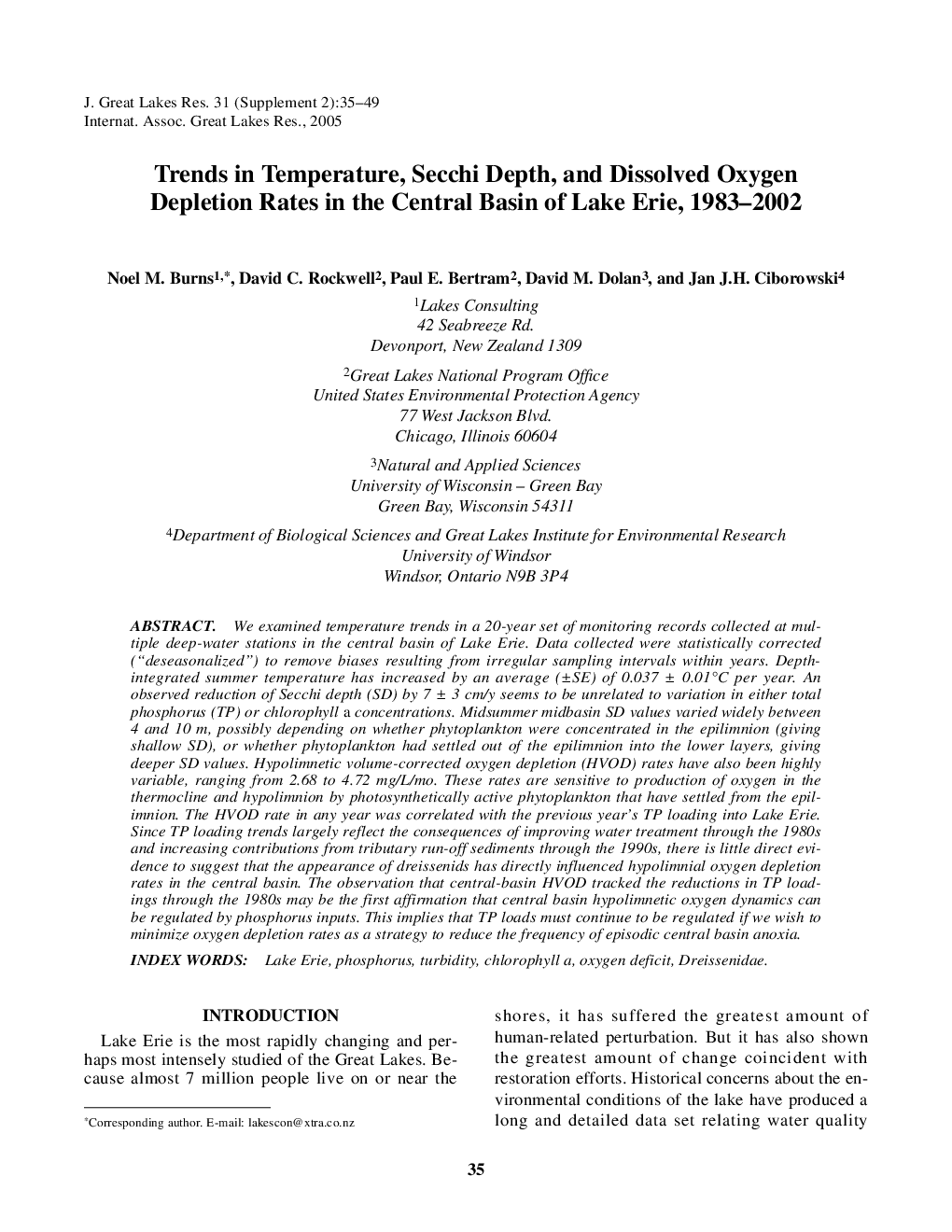| کد مقاله | کد نشریه | سال انتشار | مقاله انگلیسی | نسخه تمام متن |
|---|---|---|---|---|
| 9450238 | 1306742 | 2005 | 15 صفحه PDF | دانلود رایگان |
عنوان انگلیسی مقاله ISI
Trends in Temperature, Secchi Depth, and Dissolved Oxygen Depletion Rates in the Central Basin of Lake Erie, 1983-2002
دانلود مقاله + سفارش ترجمه
دانلود مقاله ISI انگلیسی
رایگان برای ایرانیان
کلمات کلیدی
موضوعات مرتبط
مهندسی و علوم پایه
علوم زمین و سیارات
علوم زمین و سیاره ای (عمومی)
پیش نمایش صفحه اول مقاله

چکیده انگلیسی
We examined temperature trends in a 20-year set of monitoring records collected at multiple deep-water stations in the central basin of Lake Erie. Data collected were statistically corrected (“deseasonalized”) to remove biases resulting from irregular sampling intervals within years. Depthintegrated summer temperature has increased by an average (±SE) of 0.037 ± 0.01°C per year. An observed reduction of Secchi depth (SD) by 7 ± 3 cm/y seems to be unrelated to variation in either total phosphorus (TP) or chlorophyll a concentrations. Midsummer midbasin SD values varied widely between 4 and 10 m, possibly depending on whether phytoplankton were concentrated in the epilimnion (giving shallow SD), or whether phytoplankton had settled out of the epilimnion into the lower layers, giving deeper SD values. Hypolimnetic volume-corrected oxygen depletion (HVOD) rates have also been highly variable, ranging from 2.68 to 4.72 mg/L/mo. These rates are sensitive to production of oxygen in the thermocline and hypolimnion by photosynthetically active phytoplankton that have settled from the epilimnion. The HVOD rate in any year was correlated with the previous year's TP loading into Lake Erie. Since TP loading trends largely reflect the consequences of improving water treatment through the 1980s and increasing contributions from tributary run-off sediments through the 1990s, there is little direct evidence to suggest that the appearance of dreissenids has directly influenced hypolimnial oxygen depletion rates in the central basin. The observation that central-basin HVOD tracked the reductions in TP loadings through the 1980s may be the first affirmation that central basin hypolimnetic oxygen dynamics can be regulated by phosphorus inputs. This implies that TP loads must continue to be regulated if we wish to minimize oxygen depletion rates as a strategy to reduce the frequency of episodic central basin anoxia.
ناشر
Database: Elsevier - ScienceDirect (ساینس دایرکت)
Journal: Journal of Great Lakes Research - Volume 31, Supplement 2, 2005, Pages 35-49
Journal: Journal of Great Lakes Research - Volume 31, Supplement 2, 2005, Pages 35-49
نویسندگان
Noel M. Burns, David C. Rockwell, Paul E. Bertram, David M. Dolan, Jan J.H. Ciborowski,